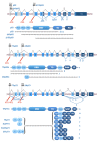Isoforms of the p53 Family and Gastric Cancer: A Ménage à Trois for an Unfinished Affair
- PMID: 33671606
- PMCID: PMC7926742
- DOI: 10.3390/cancers13040916
Isoforms of the p53 Family and Gastric Cancer: A Ménage à Trois for an Unfinished Affair
Abstract
Gastric cancer is one of the most aggressive cancers, with a median survival of 12 months. This illustrates its complexity and the lack of therapeutic options, such as personalized therapy, because predictive markers do not exist. Thus, gastric cancer remains mostly treated with cytotoxic chemotherapies. In addition, less than 20% of patients respond to immunotherapy. TP53 mutations are particularly frequent in gastric cancer (±50% and up to 70% in metastatic) and are considered an early event in the tumorigenic process. Alterations in the expression of other members of the p53 family, i.e., p63 and p73, have also been described. In this context, the role of the members of the p53 family and their isoforms have been investigated over the years, resulting in conflicting data. For instance, whether mutations of TP53 or the dysregulation of its homologs may represent biomarkers for aggressivity or response to therapy still remains a matter of debate. This uncertainty illustrates the lack of information on the molecular pathways involving the p53 family in gastric cancer. In this review, we summarize and discuss the most relevant molecular and clinical data on the role of the p53 family in gastric cancer and enumerate potential therapeutic innovative strategies.
Keywords: biomarker; cell death; chemotherapy; gastric cancer; immunotherapy; isoforms; metastasis; p53 family; personalized therapy; tumor ecosystem.
Conflict of interest statement
The authors declare no conflict of interest.
Figures





Similar articles
-
TP53 family members and human cancers.Hum Mutat. 2003 Mar;21(3):182-91. doi: 10.1002/humu.10172. Hum Mutat. 2003. PMID: 12619104 Review.
-
P53 family: at the crossroads in cancer therapy.Curr Med Chem. 2009;16(32):4328-44. doi: 10.2174/092986709789578196. Curr Med Chem. 2009. PMID: 19754415 Review.
-
Identification of DeltaN isoform and polyadenylation site choice variants in molluscan p63/p73-like homologues.Mar Biotechnol (NY). 2007 Mar-Apr;9(2):217-30. doi: 10.1007/s10126-006-6045-1. Epub 2007 Jan 22. Mar Biotechnol (NY). 2007. PMID: 17242983
-
Clinical relevance of dominant-negative p73 isoforms for responsiveness to chemotherapy and survival in ovarian cancer: evidence for a crucial p53-p73 cross-talk in vivo.Clin Cancer Res. 2005 Dec 1;11(23):8372-83. doi: 10.1158/1078-0432.CCR-05-0899. Clin Cancer Res. 2005. PMID: 16322298
-
The dominant-negative interplay between p53, p63 and p73: A family affair.Oncotarget. 2016 Oct 25;7(43):69549-69564. doi: 10.18632/oncotarget.11774. Oncotarget. 2016. PMID: 27589690 Free PMC article.
Cited by
-
Exploring the potential of machine learning in gastric cancer: prognostic biomarkers, subtyping, and stratification.BMC Cancer. 2025 Apr 30;25(1):809. doi: 10.1186/s12885-025-14204-x. BMC Cancer. 2025. PMID: 40307780 Free PMC article.
-
Morpho-functional analysis of patient-derived xenografts reveals differential impact of gastric cancer and chemotherapy on the tumor ecosystem, affecting immune check point, metabolism, and sarcopenia.Gastric Cancer. 2023 Mar;26(2):220-233. doi: 10.1007/s10120-022-01359-w. Epub 2022 Dec 19. Gastric Cancer. 2023. PMID: 36536236 Free PMC article.
-
Phospholipase D regulates ferroptosis signal transduction in mouse spleen hypoxia response.Braz J Med Biol Res. 2024 Mar 4;57:e13218. doi: 10.1590/1414-431X2023e13218. eCollection 2024. Braz J Med Biol Res. 2024. PMID: 38451609 Free PMC article.
-
The Role of TP53, KRAS, CDH1, Demographic and Clinical Variables in Gastric Cancer.Mater Sociomed. 2024;36(4):280-287. doi: 10.5455/msm.2024.36.280-287. Mater Sociomed. 2024. PMID: 39963439 Free PMC article.
-
Circadian rhythm genes contribute to the prognosis prediction and potential therapeutic target in gastric cancer.Sci Rep. 2024 Oct 25;14(1):25426. doi: 10.1038/s41598-024-76565-w. Sci Rep. 2024. PMID: 39455662 Free PMC article.
References
Publication types
Grants and funding
LinkOut - more resources
Full Text Sources
Other Literature Sources
Research Materials
Miscellaneous

